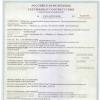Rinonorm Teva: instructions for use, analogues and reviews, prices in Russian pharmacies. The use of Rinonorm for rhinitis: instructions for children and adults Rinonorm side effects
Rinonorm: release form, application, dosage, side effects
Rinonorm is a drug intended for local vasoconstriction, widely used in ENT practice. It is produced in the form of a spray, with a dosage of 0.05% (for use in the children's age group) and 0.1%. The liquid is colorless, transparent, packaged in dark glass bottles equipped with nasal nozzles. The capacity of one bottle is 15 ml. The main component of the drug is xylometazoline hydrochloride. Excipients are citric acid monohydrate, 85% glycerol, sodium citrate dihydrate and water for injections.
In the process of application, the solution narrows the arterioles, while the swelling of the mucous tissues of the nasopharynx decreases and the level of secretions decreases. The positive effect of the drug manifests itself quite quickly, already after a few minutes, while the action itself lasts from 6 to 8 hours, during which normal breathing, the patency of the nasal sinuses and the Eustachian tube are restored. In the case of topical application, xylometazoline is absorbed into the blood in minimal doses, which means that its concentration in the blood is very low.
Rhinonorm is shown as an element complex treatment for symptomatic therapy with:
- Rhinitis caused by allergies;
- Acute bacterial or viral rhinitis;
- Acute sinusitis and exacerbations of chronic sinusitis;
- Acute otitis media to be able to reduce swelling of the Eustachian tube mucosa;
- Preparation prior to the diagnosis of the nasal passages.
The dosages prescribed by the instructions for the age group over 10 years of age are as follows: I use Rinonorm 0.1% in the amount of 1 dose (1 dose corresponds to 1 pressing of the nasal nozzle) in each nostril no more than 3 times a day. The maximum dosage is up to 7 doses per day, it should be borne in mind that the gap between doses should be at least 6 hours. Possible complications in the form of recurrence of symptoms should be taken into account in cases where the drug is taken for more than a 7-day period.
Before you start using Rinonorm, you must first clean the nasal passages. In the process of introducing the solution, a small breath is taken through the nose.
When using Rinonorm, it is possible side effects in the form of burning and the appearance of dryness in the nose, in rare cases, irritation of the larynx, oral cavity and nasal mucosa appears. With regard to the central nervous system manifestations in the form of headaches and sleep disturbances are possible. Cardiovascular disorders can be manifested by the appearance of arrhythmia and an increase in blood pressure. Rarely, nausea and skin rashes are possible.
In cases of overdose, which are quite rare, arrhythmia may occur, as well as an increase in blood pressure, sometimes loss of consciousness is possible. In such cases, symptomatic treatment with the participation of a specialist is necessary. Also shown is the use of activated charcoal and gastric lavage in cases of accidental ingestion of the solution inside.
Rinonorm is forbidden to be taken in cases of atrophic rhinitis; with angle-closure glaucoma; in cases where the patient has already been prescribed MAO inhibitors or tricyclic antidepressants; with individual intolerance to patients of any components of the drug. You should also remember about age restrictions: for a spray with a concentration of 0.05%, the age group should not be younger than two years, for a spray with a concentration of 0.1% - not younger than 10 years. With some caution, the remedy is prescribed for problems of the cardiovascular system, with diabetes, with hyperthyroidism, with arterial hypertension.
Rhinonorm for children
Rinonorm in the form of a spray of 0.05% is prescribed for the age category not younger than 2 years. The dosage of the drug is 1 dose in each nostril up to 3 times in 24 hours. Children of the group over 10 years of age and the adult category of patients are prescribed Rinonorm in the form of a spray of 0.1% at the rate of 1 dose in each nostril no more than 3 times in 24 hours.
The main limiter for the use of Rinonorm is the age of children, which should not be less than 2 years for a drug with a concentration of 0.05% and at least 10 years for a drug of 0.01%
Rinonorm during pregnancy
The drug Rinonorm is not recommended for pregnant women, as well as women during breastfeeding. Despite the over-the-counter form of distribution of the drug, this remedy can be prescribed to pregnant and lactating mothers only by the attending physician, having previously compared the expected benefits with possible negative consequences.
Rhinonorm: price
Depending on the concentration of the drug, the region of distribution of the drug, as well as on the distributor itself, the price of Rinonorm may vary: in Ukraine from 20.90 to 26.84 UAH; in Russia from 68 to 71 rubles.
Rinonorm: reviews
- The drug, like any other medical device, has its advantages and disadvantages. The advantages include ease of use and a fairly low price, as for the disadvantages, for me the main thing was short action Rhinonorm. However, I use it with pleasure when the allergy presses.
- Used the spray
Spray Rhinonorm has vasoconstrictive and anti-inflammatory action. Rhinonorm contains xylometazoline hydrochloride - a substance of the alpha-adrenergic agonist group used in ENT practice.
When using a spray Rhinonorm mucosal vasoconstriction is noted paranasal sinuses and nose, resulting in reduced hyperemia and swelling of tissues, as well as reduced severity of rhinorrhea.
Rhinonorm helps to restore the patency of the openings of the sinuses and Eustachian tubes, facilitate nasal breathing, as well as a general improvement in the patient's condition. Xylometazoline reduces the risk of developing complications due to mucus stasis.
The local effect of the drug Rinonorm develops within 3-5 minutes after intranasal use and lasts at least 6 hours (depending on the individual characteristics of the patient, the effect of xylometazoline lasts for 6-10 hours).
Systemic absorption active ingredient the drug Rinonorm with intranasal use is negligible.
Indications for use:
Rhinonorm used for local therapy patients suffering acute rhinitis various etiologies, including bacterial, viral and allergic rhinitis.
Rinonorm is prescribed to patients with acute form sinusitis, including during an exacerbation of chronic sinusitis.
V complex therapy Rinonorm can be prescribed to patients with acute form of otitis media (in order to reduce swelling of the tissues of the mucous membrane of the Eustachian tube).
Spray Rhinonorm can be prescribed to patients to reduce hyperemia, swelling and discomfort during diagnostic procedures in the nasal passages.
Mode of application:
A drug Rhinonorm intended for intranasal use. Before using the drug, the nasal passages should be cleared of mucus. Before the first use, it is recommended to make several sprays to achieve the optimal dosage of the drug. The tip of the spray nozzle should be inserted shallowly into the nasal passage and pressed on the piston device. Spraying is recommended during a light breath through the nose.
In the treatment of adults and adolescents, as a rule, 1 spray of the drug is prescribed. Rhinonorm 0.1%
In the treatment of children older than 2 years, as a rule, 1 spray of the drug is prescribed. Rinonorm 0.05% in each nasal passage. Spray is used no more than 3 times a day.
The minimum recommended interval between spray applications is 6 hours.
1 dose of Rinonorm corresponds to 0.14 ml of solution.
Rinonorm should not be used for more than 7 days in a row.
Side effects:
When using the drug Rhinonorm patients may develop local side effects in the form of dryness, burning and irritation of the mucous membrane of the larynx, nose and oral cavity. In rare cases, the development of reactive hyperemia and swelling of the nasal mucosa was noted.
In addition, intranasal use of xylometazoline may cause nausea and headache.
With prolonged and frequent use of the drug Rhinonorm patients may develop drug-induced rhinitis with further development of atrophy and the formation of scabs in certain areas of the nasal mucosa.
When using high doses of xylometazoline in patients, systemic adverse reactions may develop, including arrhythmia, hyperexcitability, arterial hypertension and skin allergic reactions.
Contraindications:
Rhinonorm do not prescribe to patients with a history of hypersensitivity reactions to xylometazoline or additional ingredients of the spray.
Rinonorm is not used in the treatment of patients with atrophic rhinitis, angle-closure glaucoma, as well as patients who have undergone hypophysectomy.
Rinonorm is not used in patients receiving therapy with monoamine oxidase inhibitors or tricyclic antidepressants.
Rinonorm 0.05% v pediatric practice used only for the treatment of children older than 2 years.
Rhinonorm 0.1% in pediatric practice, they are used only for the treatment of children older than 10 years.
Caution is advised when prescribing Rinonorm to patients suffering from severe heart disease, arterial hypertension, hyperthyroidism and diabetes mellitus.
Rinonorm should be used with caution in patients receiving bromocriptine therapy.
Pregnancy:
During pregnancy and lactation, the use of the drug Rhinonorm not recommended due to the lack of reliable data on the effect of xylometazoline on fetal development, pregnancy and the condition of children under breastfeeding whose mothers used xylometazoline intranasally.
Interaction with others medicines:
Tricyclic and tetracyclic antidepressants when used in combination with the drug Rhinonorm increase the risk of systemic effects of xylometazoline.
It is possible to develop severe arterial hypertension with the combined use of the drug Rinonorm with drugs that inhibit monoamine oxidase.
The drug should not be used Rhinonorm combined with other drugs for intranasal use, which have a vasoconstrictive effect.
Overdose:
The development of an overdose of xylometazoline was noted mainly in children and was accompanied by the development of systemic undesirable effects of the drug. In particular, when using excessive doses of Rinonorm, patients may develop heart rate disorders, arterial hypertension and loss of consciousness.
With the development of signs of overdose, symptomatic therapy is carried out. Treatment should be carried out under the supervision of a physician. With the development of severe symptoms of intoxication, alpha-blockers are prescribed (including to lower blood pressure). If breathing is disturbed, artificial ventilation of the lungs is indicated, if necessary, intubation is carried out.
The use of vasoconstrictor drugs is contraindicated in case of an overdose of the drug Rhinonorm.
In case of accidental oral administration of the drug Rhinonorm prescribe the intake of enterosorbents and saline laxatives (sodium sulfate).
If no more than 30 minutes have passed since accidental oral ingestion of xylometazoline, gastric lavage may be recommended.
Release form:
Spray nasal dosed Rhinonorm for children (0.05%)
Spray nasal dosed Rhinonorm for adults (0.1%) in dark glass bottles of 10 or 15 ml, 1 bottle with a spray nozzle and a protective cap is placed in a cardboard box.
Storage conditions:
A drug Rhinonorm should be stored and transported in the original packaging temperature regime 15 to 25 degrees Celsius.
Subject to the recommendations for storage of the drug Rhinonorm is good within 3 years.
After the first application, the drug Rinonorm is suitable for 12 months.
Synonyms:
For nose, Galazolin, Xilen, Grippostad Rino, Xylometazoline, Rinasal, Otrivin, Farmazolin.
Compound:
10 ml spray Rinonorm 0.05% contain:
Xylometazoline (in the form of hydrochloride) - 5 mg;
Additional ingredients.
10 ml spray Rhinonorm 0.1% contain:
Xylometazoline (in the form of hydrochloride) - 10 mg;
Additional ingredients.
Rinonorm: instructions for use and reviews
Rinonorm is a vasoconstrictor that reduces hyperemia and swelling of the mucous membranes of the nasopharynx. Used in ENT practice.
Release form and composition
Dosage form - dosed nasal spray 0.05% (for children) and 0.1%: a clear colorless solution (15 ml each in dark glass bottles equipped with a dosing device and a nasal nozzle, in a pack of cardboard 1 bottle).
Active substance: xylometazoline hydrochloride - 0.5 or 1 mg per 1 ml.
Auxiliary components: citric acid monohydrate, glycerol 85%, sodium citrate dihydrate, water for injection.
Pharmacological properties
Rinonorm is characterized by a pronounced anticongestive effect on the human body.
Pharmacodynamics
The active component of the drug - xylometazoline - is an adrenomimetic that promotes narrowing of arterioles. This favorably affects the condition of the mucous membranes of the nasopharynx, reducing swelling and eliminating hyperemia. Rinonorm improves the patency of the Eustachian tubes, sinus openings and nasal passages, and also reduces the risk of complications associated with prolonged secretion stagnation.
Pharmacokinetics
At topical application Rhinonorm the amount of secretion in the nasopharynx decreases within a few seconds after the intake of xylometazoline in the body. The effect of the drug persists for another 3-4 hours.
Indications for use
Symptomatic treatment:
- Acute sinusitis and exacerbation of chronic sinusitis;
- Acute rhinitis of bacterial and viral origin;
- Acute allergic rhinitis;
- Acute otitis media (to reduce swelling of the mucous membrane of the Eustachian tube).
According to the instructions, Rinonorm can also be used during the preparation of the patient for diagnostic procedures in the nasal passages.
Contraindications
- Children's age up to 2 years - for 0.05% spray, up to 10 years - for 0.1% spray;
- Atrophic (dry) rhinitis;
- Conditions after hypophysectomy;
- Angle-closure glaucoma;
- Concomitant use of tricyclic antidepressants or monoamine oxidase inhibitors;
- Pregnancy;
- Hypersensitivity to any component of Rinonorm.
Carefully:
- lactation period;
- Diabetes;
- Hyperthyroidism;
- severe heart disease;
- Arterial hypertension;
- Simultaneous use of bromocriptine.
Instructions for use Rinonorm: method and dosage
Nasal spray Rinonorm is applied intranasally.
Adults and children over 10 years of age are prescribed 0.1% spray - 1 dose in each nasal passage up to 3 times / day.
Children 2-10 years old are prescribed 0.05% spray - 1 dose in each nasal passage up to 3 times / day.
1 dose corresponds to 1 pressure on the piston and is 0.14 ml of solution.
The interval between injections should be at least 6 hours. The maximum frequency of use of the drug is 4 times a day.
Duration of continuous treatment - no more than 7 days.
Before instillation of the spray, the nasal passages should be cleared of secretions.
During the administration of the drug, you need to take a light breath through the nose.
Side effects
- Local reactions: burning sensation and dryness of the nasal mucosa; rarely - irritation of the oral mucosa, nose and / or larynx;
- From the side of cardio-vascular system: extremely rare (less than 1 case in 10,000) - violations heart rate, increased blood pressure;
- From the side of the central nervous system: rarely - headache; extremely rarely - irritability, insomnia;
- Other: rarely - nausea; extremely rarely - reactions on the skin.
Overdose
Cases of overdose of the drug have been registered mainly in children and are expressed in arrhythmia, increased blood pressure, and in some cases - fainting.
As a treatment, symptomatic therapy under the supervision of a specialist is recommended. In severe cases, use non-selective alpha-blockers to lower blood pressure, and also resort to intubation and artificial ventilation lungs. Vasoconstrictor agents are prohibited. In case of accidental intake of Rinonorm in moderate or large amounts, it is necessary to take a laxative (for example, sodium sulfate) and activated charcoal, and gastric lavage.
The cold season is traditionally considered the season of colds, viral infections, influenza. And closer to spring, many people begin to experience allergies, including a runny nose caused by this disease. Children catch colds and get sick especially easily, so it is important for parents to know which drug can be taken so that the kids recover quickly.

Release form
A well-known medicine for the common cold is "Rinonorm", which is available in the form of nasal remedies: drops, spray and gel. And manufacturers offer a special children's dosage with a reduced concentration of the active ingredient. Parents can only choose a more convenient form (drops or spray "Rinonorm" 0.05%).
Drops are sold in dark glass bottles with a pipette cap of 10 and 15 ml and in spray bottles of 10 and 15 ml with a convenient spray cap that doses the injection.


Compound
Spray and drops are a solution of the main active ingredient (xylometazoline hydrochloride). Each milligram of a nasal remedy for children contains 500 mg of this substance.
Xylometazoline hydrochloride is a topical alpha-agonist that has a vasoconstrictive effect on the nasal mucosa. Runny nose should be treated as early as possible. Here, nasal remedies "Rinonorm" come to the rescue. The vessels narrow, the swelling subsides, and the child can breathe freely again.
As auxiliary components in the preparations "Rinonorm" include stabilizers, including citric acid, glycerol. The basis of the solution is distilled water.



Operating principle
When exposed to a virus or bacterial infection on the mucous membrane, the pathogenic organism is introduced into its cells. First, dryness and burning in the nose appear, and then swelling of the mucous membrane occurs. Simultaneously with edema, active secretion begins, nasal congestion appears.
Some parents believe that a cold is not caused by an infection, so it does not need to be treated. In itself, hypothermia, which, as a rule, leads to a cold, is really not a disease. But the disease we call a cold occurs when a child's immune system weakens due to hypothermia. At this point, children are more vulnerable to bacterial infections.

A runny nose is not a completely harmless disease. Difficulty breathing leads to a decrease in the concentration of oxygen in the blood. Internal organs and the baby's tissues begin to lack it. This condition is called hypoxia. Prolonged hypoxia adversely affects the health of children.
When using "Rinonorm" alpha-adrenomimetic, getting on the mucous membrane, contributes to the narrowing of arterioles (small arteries in the nose). The rush of blood to the mucosa is reduced, the swelling subsides, the redness also becomes less pronounced. When breathing is restored, children begin to feel better, the lethargy, drowsiness that accompanies shortness of breath disappears.
The action of nasal remedies "Rinonorm" lasts up to 6-8 hours. Therefore, if you give them to your child before bedtime, then he is guaranteed to sleep peacefully all night.

In addition, timely treatment started will avoid various complications in which inflammation can spread to the mucous membrane of the pharynx and larynx. This can cause diseases such as sinusitis, laryngitis, pharyngitis, otitis media.
If the appearance of a runny nose is associated with a seasonal exacerbation of an allergy or contact with an allergen, then the action of "Rinonorm" will also alleviate this condition. In this case, the remedy should be used in combination with anti-allergic drugs.

Indications
Nasal remedies "Rhinonrom" can be taken if the child has a runny nose, regardless of its cause: a viral, bacterial infection or an allergy. "Rinonorm" is indicated for acute sinusitis, i.e. inflammation of the paranasal cavities, as well as for exacerbation chronic stage this disease.
When a child has a runny nose, you can use the children's "Rinonorm" even before consulting a doctor, since it is important to "capture" the disease at the very beginning and prevent it from developing. But it is necessary to consult a doctor if the child is sick. Parents can write down the names of all the medicines they gave the child, and the doctor, based on the symptoms and individual indicators of the child's health, can adjust the treatment method.

"Rinonorm" is also successfully used as part of complex therapy in the treatment of otitis media. The drug relieves swelling and alleviates the condition of the child. But immediately apply "Rinonorm" if the child has an earache, it is not worth it. It is better to first consult a doctor who will prescribe the appropriate treatment.
"Rinonorm" is also shown in preparing children for various manipulations, procedures and surgical operations in the nose.

At what age are they prescribed?
Even in a children's dosage, doctors do not recommend giving a child under 2 years of age "Rinonorm". This is due to the characteristics of young children, in whom many physiological processes in the body proceed differently than in adults and older children. Especially vulnerable in this sense are babies under the age of one year.
The appearance of a runny nose in a small child who cannot breathe through his mouth is very dangerous. Parents should immediately contact a doctor who will recommend an approved drug. Pharmacists in pharmacies are also qualified to advise the right medicine for the baby.

Contraindications
Strict contraindications to the use of drugs "Rinonorm" is increased individual sensitivity to the components. It is also not recommended to use an alpha-agonist if the child's nose has mucosal damage: wounds, scratches, crusts.
Alpha-agonists are not used simultaneously with inhibitors and tricyclic antidepressants.
The use of nasal preparations "Rinonorm", intended for adults, is contraindicated for children under 10 years of age. In the absence of a medicine with a child dosage, many parents decide to give the child an adult "Rinonorm". But doctors believe that this is not necessary. The use of the drug with more high concentration the active ingredient can lead to overdose symptoms and worsening of the child's condition.

Only under the constant supervision of a doctor, "Rinonorm" is given to children suffering from diabetes, severe heart disease.
Side effects
In some cases, after the use of nasal preparations "Rinon", a local reaction may occur in the form of a feeling of dryness or burning in the nose, and sometimes in the oral mucosa, larynx. Children may complain of headache, bad dream, sometimes parents note increased excitability and poor health of the child, sometimes there may be an increase in pressure. In the most severe cases, nausea and skin rashes may occur.

If one of these symptoms is noticed, even if there is a possibility that its appearance is not associated with "Rinonorm", you need to suspend treatment with the drug and consult a doctor. If treatment is continued, the symptoms may worsen, and the child's condition may worsen.
Instructions for use
Before intranasal administration of the drug, it is necessary to clear the child's nose of accumulated mucus.
When using the spray for a child aged 2 to 10 years, it is recommended to do one injection up to 3 times a day. One injection corresponds to 0.14 ml of solution. At the same time, at least 6 hours should elapse between two doses.
For children over 10 years of age adult form spray with a concentration of 0.1%. Also, one injection in each nasal passage is enough, no more than 3 times a day. The total duration of treatment is no more than 7 days.

The use of a drop of "Rinonorm" for children from 0 to 6 years is allowed 1-2 times a day, 1-2 drops. For this age category, Rinonorm 0.05% drops are used. Children over 6 years old are given drops of "Rinonorm" 0.1%, 2-3 drops up to 4 times a day.
Nasal gel "Rinonorm" can only be given to children older than 7 years. The gel is placed in the nose up to 4 times a day, including at bedtime.
Overdose
In the treatment of drugs "Rinonorm" overdose is observed in rare cases. Symptoms are increased blood pressure, arrhythmia. With a large overdose, loss of consciousness is possible.
If a child accidentally took a large amount of the drug inside, it is urgent to call " ambulance» . If for some reason it is impossible to call specialists, you should do a gastric lavage on your own. It's not the most pleasant procedure. The child should be given from 150 ml (for newborns) to 600 ml of water (for children from 7 years old). Then you need to induce vomiting in the child.

It is important to consider that gastric lavage is only effective for one to two hours after taking the medicine.
In any case, after washing, or if it was not possible to do it, you need to give the child activated charcoal or any sorbent, as well as a laxative. This will help to remove unwanted substances from the body as quickly as possible.
Doctors advise taking alpha-agonist overdose seriously, as it is a strong vasoconstrictor.

Interaction with other drugs
It is known that simultaneous administration with MAO inhibitors leads to an increase in pressure, and when combined treatment with "Rinonorm" with tri- or tetracyclic antidepressants, the effect of the drug is enhanced, which can cause overdose symptoms.
Terms of sale and storage
Preparations "Rinonorm" are classified as non-prescription drugs. After purchase at a pharmacy, a bottle or cartridge should be stored at an air temperature not higher than 25 C. If the container is kept closed, then the shelf life is 3 years from the date of issue. After opening, you can use the medicine for one year. The production date is always indicated on the packaging.
nasal spray dosed
Owner/Registrar
ratiopharm GmbH
International Classification of Diseases (ICD-10)
H66 Purulent and unspecified otitis media J00 Acute nasopharyngitis (runny nose) J01 Acute sinusitis J30.1 Pollen allergic rhinitis J30.3 Others allergic rhinitis J32 Chronic sinusitis Z51.4 Preparatory procedures for subsequent treatment, not elsewhere classifiedPharmacological group
Vasoconstrictor drug for local use in ENT practice
pharmachologic effect
Alpha-agonist for local use in ENT practice.
When applied topically, xylometazoline causes narrowing of arterioles, leads to a decrease in hyperemia and swelling of the mucous membranes of the nasopharynx and a decrease in secretions. distinct local action the drug is detected after a few minutes and persists for several hours (up to 6-8 hours), manifesting itself in the restoration of the patency of the nasal passages, sinus openings and Eustachian tubes. Restoration of air permeability of the nasopharynx improves the patient's well-being and reduces the risk possible complications caused by congestion of the mucous secretion.
Pharmacokinetics
When applied topically, xylometazoline is practically not absorbed, so plasma concentrations are very low (not analytically determined).
Rinonorm is used as a symptomatic therapy for the following diseases and conditions:
Acute viral or bacterial rhinitis;
Acute allergic rhinitis;
Acute sinusitis or exacerbation of chronic sinusitis;
Acute otitis media (to reduce swelling of the mucous membrane of the Eustachian tube);
Preparing the patient for diagnostic procedures in the nasal passages.
Atrophic (dry) rhinitis;
Angle-closure glaucoma;
Condition after hypophysectomy;
Simultaneous use of MAO inhibitors and tricyclic antidepressants;
Children's age up to 2 years (for spray for children);
Children under 10 years of age (for adult spray);
Hypersensitivity to xylometazoline or other components of the drug.
WITH caution the drug should be used for arterial hypertension, severe heart disease, hyperthyroidism, diabetes mellitus and patients taking bromocriptine.
Local reactions: burning sensation and dryness of the nasal mucosa; rarely - irritation of the nasal mucosa, oral cavity and larynx.
From the side of the central nervous system: rarely - headache; rarely (< 1/10 000) - бессонница, повышенная возбудимость.
From the side of the cardiovascular system: rarely (< 1/10 000) - аритмия, увеличение АД.
Other: rarely - nausea; rarely (< 1/10 000) - кожные реакции.
Overdose
Symptoms: in rare cases of overdose, occurring mainly in children, arrhythmia, increased blood pressure, and in some cases loss of consciousness may be observed.
Treatment: symptomatic therapy under supervision is shown. In severe cases, non-selective alpha-blockers can be used to lower blood pressure, as well as intubation and mechanical ventilation. Vasoconstrictor drugs contraindicated. If you accidentally take a moderate or large amount of the drug inside, you should take activated charcoal and a laxative (for example, sodium sulfate), do a gastric lavage.
special instructions
Influence on the ability to drive vehicles and control mechanisms
There was no effect on the ability to drive vehicles and control machines and mechanisms.
Use during pregnancy and lactation
The drug should not be taken during pregnancy.
The drug should be used with caution during breastfeeding.
drug interaction
Simultaneous use of tri- or tetracyclic antidepressants may increase the systemic exposure to xylometazoline.
While taking the drug with MAO inhibitors, there is a risk of increasing blood pressure.
Adults and children over 10 years old appoint Rinonorm nasal spray 0.1% 1 dose (1 click on the piston device) in each nasal passage no more than 3 times / day.
Children aged 2 to 10 years appoint Rinonorm nasal spray for children 0.05% 1 dose (1 press on the piston device) in each nasal passage no more than 3 times / day.
As much as possible, the drug can be used no more than 7 times / day. The interval between the administration of the drug should not be less than 6 hours.
The amount of fluid entering the patient's nasal passage (1 dose) is 0.14 ml of solution.
In order to avoid complications in the form of resumption of symptoms of the disease, the duration of continuous use of the drug should not exceed 7 days.
Before using the drug, the nasal passages should be freed from the secret. During the administration of the drug, a light breath should be taken through the nose.
Storage conditions and shelf life
The drug should be stored out of the reach of children at a temperature not exceeding 25 ° C. Shelf life - 3 years, after opening the bottle - 1 year.
Vacation from pharmacies
The drug is approved for use as a means of OTC.



















